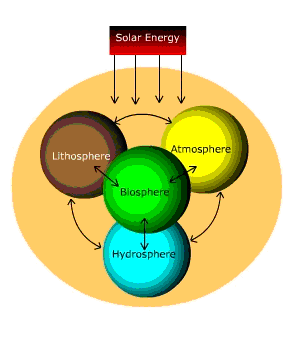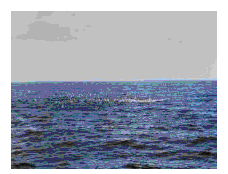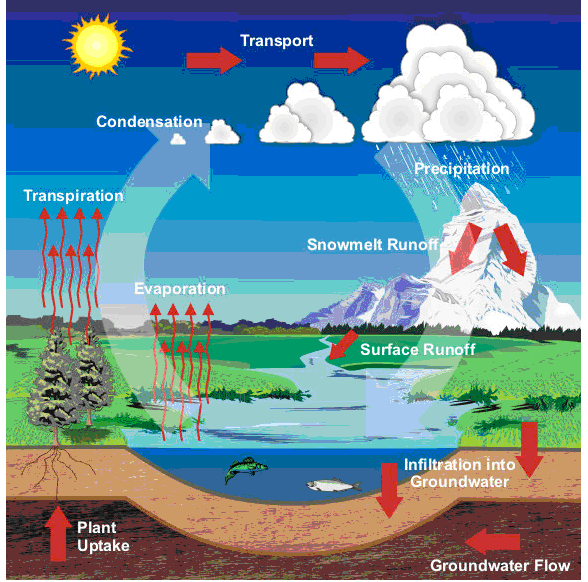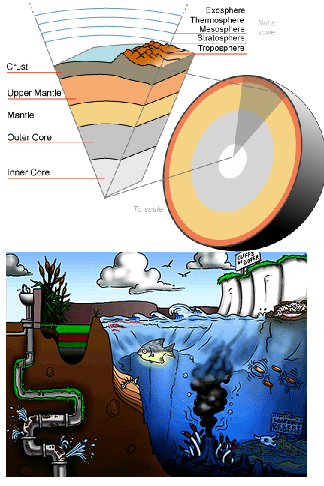The Hydrosphere
The hydrosphere is often called the “water sphere” as it includes all the earth’s water found in streams, lakes, the soil, groundwater, and in the air. The hydrosphere interacts with, and is influenced by, all the other earth spheres. The water of the hydrosphere is distributed among several different stores found in the other spheres. Water is held in oceans, lakes and streams at the surface of the earth. Water is found in vapor, liquid and solid states in the atmosphere. The biosphere serves as an interface between the spheres enabling water to move between the hydrosphere, lithosphere and atmosphere as is accomplished by plant transpiration. The hydrologic cycle traces the movement of water and energy between these various stores and spheres.
Figure TH.1 Earth Spheres/Systems
Distribution of water
The world’s oceans contain 97% of the water in the hydrosphere, most of which is salt water. Ice caps, like that found covering Antarctica, and glaciers that occupy high alpine locations, compose a little less than 2% of all water found on earth. Seemingly a small amount, the water stored as ice in glaciers would have a great impact on the environment if it were to melt into a liquid. One fear is that global warming will cause the melting and collapse of large ice sheets resulting in sea level rise. Rising sea levels could devastate coastal cities, displace millions of people, and wreak havoc on freshwater systems and habitats.
Figure TH.2 The largest store of water is the ocean which delivers water through evaporation each day
Water beneath the surface comprises the next largest store of water. Groundwater and soil water together make up about .5% of all water (by volume). There is a difference between ground water and soil water. Soil water is the water held in pore spaces between soil particles. Soil pore spaces usually are partially void of water most of the time but fill with water after a rain storm. Groundwater, on the other hand, is found where earth materials are saturated throughout the year. That is, the pore spaces are always occupied with water. Both soil and groundwater are very important sources of water. Soil water is available for plants to extract and use. Groundwater is an important source of water for irrigation and drinking water supplies.
Above the surface water is found stored in streams, rivers and lakes. One might expect that given the large rivers that flow across the earth and the huge numbers of lakes that this store would be rather large. Instead, streams, rivers and lakes only comprise .02% of all water in the earth system. In the atmosphere, only about .0001 % of the water in the hydrosphere is found.
The Hydrologic Cycle
The Hydrologic Cycle involves the continuous circulation of water in the Earth-atmosphere system. Of the many processes involved in the hydrologic cycle, the most important are
- evaporation,
- transpiration,
- condensation,
- precipitation, and
- runoff
The hydrologic cycle consists of inflows, outflows, and storage. Inflows add water to the different parts of the hydrologic system, while outflows remove water. Storage is the retention of water by parts of the system. Because water movement is cyclical, an inflow for one part of the system is an outflow for another. Looking at an aquifer as an example, percolation of water into the ground is an inflow to the aquifer. Discharge of ground water from the aquifer to a stream is an outflow (also an inflow for the stream). Over time, if inflows to the aquifer are greater than its outflows, the amount of water stored in the aquifer will increase. Conversely, if the inflows to the aquifer are less than the outflows, the amount of water stored decreases. Inflows and outflows can occur naturally or result from human activity.
Evaporation
Evaporation is the change of state in a substance from a liquid to a gas. In meteorology, the substance we are concerned about the most is water. For evaporation to take place, energy is required. The energy can come from any source; the sun, the atmosphere, the earth, or objects on the earth such as humans.
Everyone has experienced evaporation personally. When the body heats up due to the air temperature or through exercise, the body sweats, secreting water onto the skin. The purpose is to cause the body to use its heat to evaporate the liquid, thereby removing heat and cooling the body. It is the same effect that can be seen when you step out of a shower or swimming pool. The coolness you feel is from the removing of bodily heat to evaporate the water on your skin.
Transpiration
Transpiration is the evaporation of water from plants through stomata. Stomata are small openings found on the underside of leaves that are connected to vascular plant tissues. In most plants, transpiration is a passive process largely controlled by the humidity of the atmosphere and the moisture content of the soil. Of the transpired water passing through a plant only 1% is used in the growth process of the plant. The remaining 99% is passed into the atmosphere.
Condensation
Condensation is the process whereby water vapor in the atmosphere is returned to its original liquid state. In the atmosphere, condensation may appear as clouds, fog, mist, dew or frost, depending upon the physical conditions of the atmosphere. Condensation is not a matter of one particular temperature but of a difference between two temperatures; the air temperature and the dewpoint temperature.
Precipitation
Precipitation is the result when the tiny condensation particles grow too large, through collision and coalesce, for the rising air to support, and thus fall to the earth.
Runoff
Runoff occurs when there is excessive precipitation and the ground is saturated (cannot absorb anymore water). This runoff flows into streams and rivers and eventually back into the sea.
Evaporation of this runoff into the atmosphere begins the hydrologic cycle over again. Some of the water perculates into the soil and into the ground water only to be drawn into plants again for transpiration to take place.
lithosphere
The lithosphere[1] is the solid shell of a rocky planet called earth. That means the crust and the upper part of the mantle which is joined to the crust (see picture on the right).
Under the lithosphere there is the asthenosphere, the weaker, hotter, and deeper part of the upper mantle.
The lithosphere is the surface layer of the fluid parts of the Earth’s convection system, therefore it thickens over time. It is broken up into pieces called plates (shown in picture on the left), which move independently relative to one another. This movement of lithospheric plates is described as plate tectonics.
The division of Earth’s outer layers into lithosphere and asthenosphere should not be confused with the chemical subdivision of the outer Earth into mantle, and crust. All crust is in the lithosphere, but lithosphere generally contains more mantle than crust.
There are two types of lithosphere:
- Oceanic lithosphere, which is associated with Oceanic crust
- Continental lithosphere, which is associated with Continental crust
Oceanic lithosphere is typically about 50-100 km thick (but beneath the mid-ocean ridges is no thicker than the crust). Continental lithosphere is thicker (about 150 km). It consists of about 50 km of crust and 100 km or more of uppermost mantle.
Oceanic lithosphere consists mainly of mafic crust and ultramafic mantle and is denser than continental lithosphere, for which the mantle is associated with crust made of felsic rocks. The crust is distinguished from the upper mantle by the change in chemical composition that takes place at the Moho discontinuity. Oceanic lithosphere thickens as it ages and moves away from the mid-ocean ridge. This thickening occurs by conductive cooling, which converts hot asthenosphere into lithospheric mantle, and causes the oceanic lithosphere to become increasingly dense with age. Oceanic lithosphere is less dense than asthenosphere for a few tens of millions of years, but after this becomes increasingly denser than asthenosphere. The gravitational instability of mature oceanic lithosphere has the effect that at subduction zones the oceanic lithosphere invariably sinks underneath the overriding lithosphere, which can be oceanic or continental. New oceanic lithosphere is constantly being produced at mid-ocean ridges and is recycled back to the mantle at subduction zones. As a result, oceanic lithosphere is much younger than continental lithosphere: the oldest oceanic lithosphere is about 170 million years old, while parts of the continental lithosphere are billions of years old.
Another distinguishing characteristic of the lithosphere is its flow properties. Under the influence of the low-intensity, long-term stresses that drive plate tectonic motions, the lithosphere responds essentially as a rigid shell and thus deforms primarily through brittle failure, whereas the asthenosphere (the layer of the mantle below the lithosphere) is heat-softened and accommodates strain through plastic deformation



